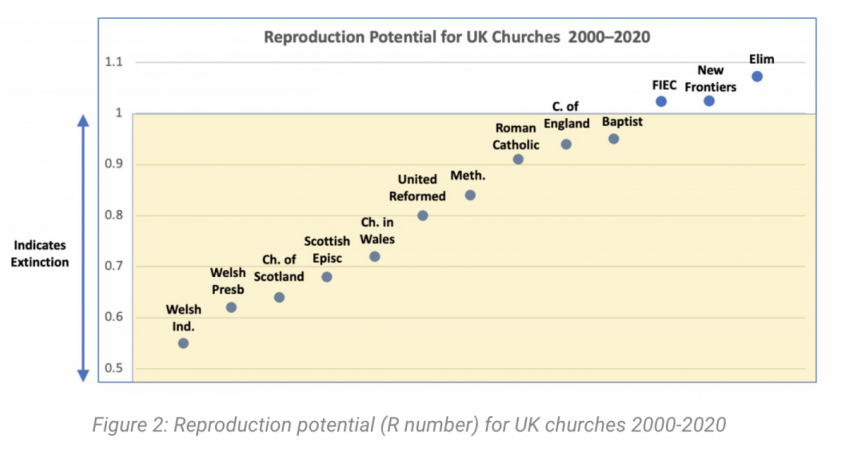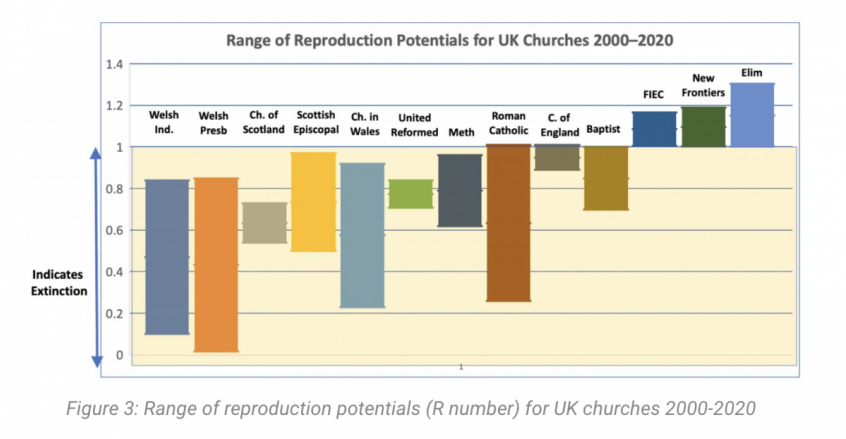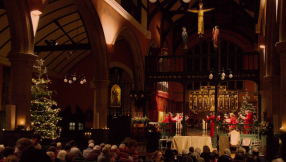
Mathematician Dr John Hayward has been crunching the numbers and the prospects for most UK Churches are not good. In fact, according to his research project, Church Growth Modelling, most denominations are facing "extinction".
This is particularly true of the historic denominations, with the few exceptions bucking the trend of decline being typically newer denominations - and evangelical.
Dr Hayward speaks to Christian Today about why so many UK Churches are facing extinction and whether anything can be done to turn this crisis around.
CT: Your report contains a stark warning of extinction for the historic denominations. How did you reach that conclusion?
John: It's helpful to think of the way that churches grow in the same way we think about how a disease spreads. We calculate how many people will be infected from one person and that gives the R number. In the same way, we can look at how the Christian faith is passed on from person to person and come up with an R number for the church - a similar concept to that of Covid and other diseases. With the R number, we can then see whether that church is heading for extinction or not.
Most decline in churches is happening in a straight, downward line i.e. they are declining at the same rate every year and if they continue to decline at this rate, then they will eventually reach zero - the extinction date. We hope of course that eventually the decline would slow down, and that these extinction dates won't come true, but sadly, at the moment, there is nothing in the data to suggest that.
It's important to stress that models don't predict what exactly is going to happen. They can only give forecasts based on the information we know at the present time. So, it is possible that the decline will slow down and hopefully the Church of England won't become extinct. But many of its older congregations are going to die out, leaving the lively, vibrant ones. That's bad news for the Church of England because the Church of England aims to cover every part of the country, but they will no longer be able to do that because they will have lost too many congregations.
CT: What's the link between death rates and the picture of decline you are seeing in the historic denominations?
John: If a congregation doesn't add anybody to their number, then the congregation gets older and, as a result, the death rate in the church gets higher. Naturally, the death rate in a church where the average age is 80 is going to be much higher than a church where the average age is 40. That's the effect we are seeing in many congregations. The majority of the congregations are elderly, they are not adding new people, they are getting older, and their death rate is increasing, and that is why we get this straight line in the data.
If they were recruiting people i.e. converting people, and those people were younger, then even if it couldn't completely stop the decline, it would still slow it down because younger people would be added to the church and that would carry it on for another generation.
CT: You have been researching church growth and decline over decades so were you surprised by the data or could you see it coming a long time ago?
John: We could see it coming a long time ago. All the data comes from Peter Brierley and his work is well known among church leaders. He has written many books warning of this. In 2015, using his data, I predicted that the Church of England would survive to the end of this century. Using the data since then has actually shown that the situation has gotten worse, not better. There will be people in the type of churches planted by Holy Trinity Brompton and St Helen's Bishopsgate who say, 'well, we're growing,' but they are outweighed by the majority of local parishes spread around the country who have not benefited from the dynamic of growth in these congregations. These congregations are not painting a true picture of the Church overall.
CT: What is the 'limited enthusiasm model' and why is it important?
John: Churches generally convert and reach new people through personal contact. What we call the 'enthusiasts' are the people who are spreading the faith, inviting people to church, explaining the Gospel to people, and bringing them to Christ. But generally speaking, people only do this for a limited amount of time either because they eventually run out of non-Christian contacts, or they get so busy in church life that they no longer have time to spend on conversion and recruitment activities.
So, the enthusiasts are limited in the amount of time they spend passing the faith on to new people. If they could spend the whole of their lives doing that, it would make a huge difference but of course people have to keep intentionally making new contacts and this usually means making new friends, which means being involved in a lot of activities outside of church life.
CT: Does the Church need more evangelists or do we just need to share our faith more?
John: The Church doesn't really need more evangelists, it needs more ordinary Christians who have contact with non-Christians and can live out the Gospel with them. It's not just about explaining the Gospel, it's often about living it out. The person who was largely responsible for bringing me to faith was my landlady who would bring out the Bible during mealtimes and ask me what I thought about it. It got me thinking that I should look into the faith a bit more and that's how I became a Christian. I saw her living out her faith.
It's people like that who are just willing to share why Jesus Christ is important to them and why his resurrection made a difference. That's something that as all Christians we should be doing all the time. It shouldn't be a limited number of people doing it for a limited amount of time.

That is what happens with a disease; people are only infectious for a short amount of time. We saw even during Covid that not all people are infectious. In Christian terms, having too few people who are infectious for the faith, and not being infectious for long enough, is what limits the growth of the church. Then the church gets older and declines because they are not adding enough people.
I think most of the Churches in the study were not adding enough new people to their numbers from about the 1870s onwards. That's when the percentage growth in the Church stopped. From the 1870s onwards, although the Churches were growing, they weren't keeping pace with the growth of the population, and by the 20th century, they weren't growing any longer. Church decline wasn't because lots of people left the Church but because they were not adding enough people.
CT: So the roots of this go back a very long way?
John: Yes, the roots go back a very long way; we're not talking about something that happened 10 or 20 years ago - or even in the 1960s. Everyone likes to blame the Sixties as that is when church decline accelerated, but that was caused by the population demographics working their way through. The true cause of church decline - its lack of conversions - goes back to the end of the 19th century. The minister, Dr Martin Lloyd-Jones was already warning in his sermons in the 1950s that the Church was going to decline more because it was not converting enough people. He saw the warning signs and was laughed at.
CT: In recent years, both the Church of England and Church of Scotland have announced plans to invest significant sums of money in mission and church growth. Have the historic Churches been too slow to react to the decline?
John: Yes, they were too slow to react but it's better to react too slowly than to not react at all! We can only hope and pray that the investment works. But the Church of England and Church of Scotland should turn as much of their money and resources as possible into mission now, rather than dying with it and passing it onto nobody.
But it's also a question of where they put the mission. In the Church of England's case, the most successful strategy they've done is to plant new churches in redundant parishes. This is something that Holy Trinity Brompton and others have done quite a lot of.
But it needs to be with paid staff. In the British context, full-time paid ministers make a huge difference to congregations. In other parts of the world, they don't even know what a paid minister is! Everything is done by lay people. But in the British context and certainly in the Church of England, having full-time paid ministers makes sense as it is what people are used to. It can be especially effective when they are put in places where there's an obvious need for a church, for example, where a previous church died out. The new minister and team can start afresh. If you look at the FIEC, Elim Pentecostal and Gospel Partnerships around the London area, their growth is largely coming from church planting.
CT: So it's not all doom and gloom - there are some churches that are growing.
John: No, it's not all doom and gloom but if people want to get back to a time when Christianity was central to the nation and the Church was central to its influence, they're looking at the wrong model. We see this in the USA too, where they are about to face a rapid Church decline, even among stalwarts like the Southern Baptists.
Christians in the USA have tried to keep the culture Christian by political campaigns. But culture becomes Christian because we spread the faith to people who aren't Christians. We can't artificially keep a culture Christian; we need to concentrate on making converts. Our job is to grow the church and change people. The culture changes because people change.
The Western Church needs to learn from all the Churches that are growing in parts of the world where the prevailing culture is not Christian at all. The Churches in these parts of the world have learnt to adapt and grow in that environment. The Western Church needs to learn from that model and remember, we're building the Kingdom of God, we're not building the country. We can be involved in the country but we shouldn't spend all our time fighting the culture around us. Rather, we influence it through our witness for Christ.
CT: You've mentioned church planting as contributing to the success of growing churches. Have you noticed anything else?
John: What I have noticed in these churches is an optimism and a great confidence in what God can do, what the Gospel is, and what the Bible teaches. They're not having long debates about 'does the Bible really say this or does it say that?'. Or 'can we change this or can we change that?'. The sorts of debates in the Church of England and Methodist Church about changing definitions of marriage don't exist in the growing denominations. They know where they stand, they know what they believe, and they don't mind if people don't like them because being liked is not their aim in life.

And within their own churches they feel secure. They're not wondering 'what are they going to say this week?' or 'what part of Christianity is going to be changed this week?'. That doesn't just apply to evangelical churches, but to Catholic and Orthodox churches as well. Part of the growth of Orthodox churches in the UK is migration but it's also due to conversion because they are confident in what they believe. It's a case of: we believed this in, for example, the 9th century and we haven't changed.
That sense of history does make a huge difference. A lot of churches today are almost ignorant of Christian history, what God has done in the past, and what Christians believed. It's almost like changing things for the sake of changing things in the hope that it will work. Continuity with the past makes churches strong and helps growth.
CT: One set of figures that really stands out is the decline in liberal churches and the growth in churches that are evangelical. Would it be reasonable to draw the conclusion that the liberal churches should return to the historic Christian faith?
John: They should but it's not always as straightforward as that. That's where you need teachers and full-time church leaders, because taking the church back to the basics of the Gospel and the authority of Scripture probably takes about 20 years in a congregation, and that means long-term ministry by people who are full-time leaders.
And they need to be put into a context where there's a reasonable expectation of a positive response. That is why It is sometimes easier to plant a new church than change an old one. For example, if a new minister with evangelical beliefs is placed in a liberal congregation and challenges the people's beliefs then he or she risks a reaction, and the people become more entrenched in their beliefs.
Christians of different beliefs shouting at each other doesn't achieve very much, so patience in the long-term is something the Church has to get used to. To expect a church to turn around in five years is unrealistic. Down through history, God has built slowly and surely over long periods.
CT: A bit like 'chicken or egg', do you think secular culture has played into the Church decline or did the Church decline first and cause this secularisation we are seeing?
John: What others call chicken and egg, we mathematicians like to call feedback. The cause has an effect, and the effect feeds back on the cause, but it really is chicken and egg because they do feed off each other.
The Church grew quite substantially from the early 1700s to about the 1870s and became very respectable in the eyes of society. When things become respectable, the Church becomes complacent, and is less inclined to seek converts. Consequently, the Church declines, and society slowly becomes more secular. To try and keep up with society and keep its respectability, the Church becomes more secular rather than seek converts, so decline gets worse.
This is what I call institutional decline. It happens not only in churches but in organisations and companies when they lose their original mission. It's a phenomenon in all human organisations and the Church has been particularly guilty of it.
Once the Church gained this respectability in society, it was very difficult to see it lost. Yet historically, the Church has always been better when it was on the margins. Actually, in England, they never had more than 50% of the population in church. It's only in Wales and Scotland that they just about managed to get to 50% in church on a Sunday. If you're interested in building a church, 50% in church sounds fantastic. If you're interested in saving the lost and spreading the kingdom, the fact that 50% are not in church is appalling and means there's a lot of work to be done.
Once church and society get mixed up it's very difficult to disentangle them and it becomes a chicken and egg situation that helps the decline on its way.
CT: What message do you think these figures should send to the Churches that are declining?
John: 2 Chronicles 7 comes to mind: "If my people, who are called by my name, will humble themselves and pray and seek my face and turn from their wicked ways, then I will hear from heaven, and I will forgive their sin and will heal their land."
The figures should not cause people to despair but do what Hezekiah and other Old Testament kings did - take it to the Lord and seek Him with an open Bible. We have to believe in this stuff and act upon it because it is God who will make the difference, not us. The figures should drive us back to God.













